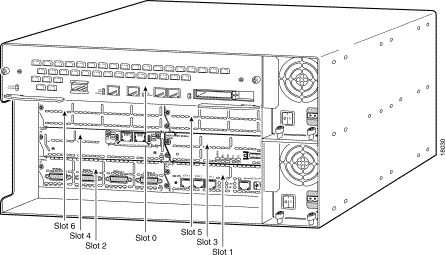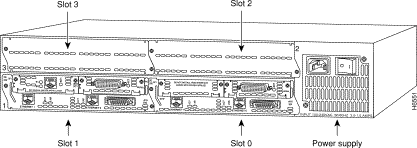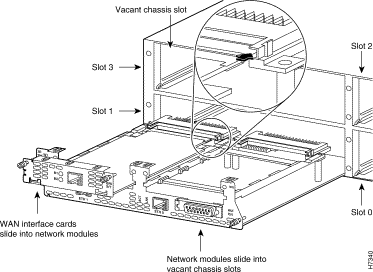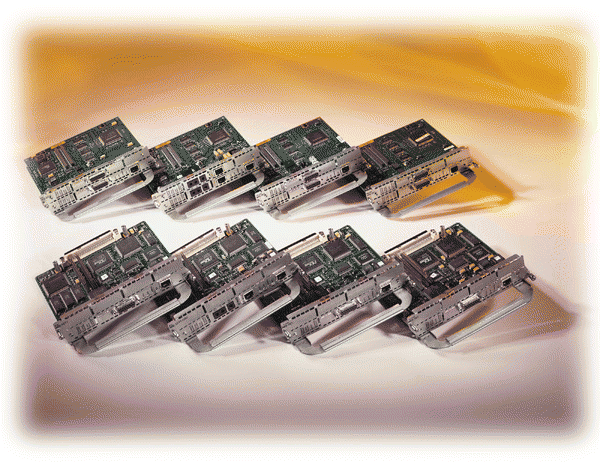
Cisco 3600 Series - Modular, High-Density Access Routers
The modular Cisco 3600 series is available as a two- or four-slot chassis. Each chassis supports a wide array of network modules, making the platform highly con\xde gurable to meet current and future connectivity requirements. It is sometimes dif\xde cult to ascertain just how requirements will change in the future, so the Cisco 3600 platform is designed to shift in any number of directions to meet evolving needs in dial access, routing or LAN-to-LAN, and multiservice voice, video, and data integration.
Cisco 3600 Series




Each network module slot accepts a variety of network module interface cards, including LAN and WAN mixed media cards supporting Ethernet, Fast Ethernet, Token Ring, and a variety of WAN technologies. These cards provide the foundation of LAN and WAN connectivity on a single, modular, network module.
Additional applications are supported with a series of network module cards offering digital modems, asynchronous and synchronous serial, ISDN PRI, and ISDN BRI interfaces. In addition to the 6 network module slots the Cisco 3660 has 2 internal Advanced Integration Module (AIM) slots for applications such as hardware accelerated compression and the chassis incorporates 1 or optionally 2 integrated 10/100 (Ethernet/Fast Ethernet) ports.
Key Features and Benefits
The Cisco 3660, Cisco 3640, and Cisco 3620 routers support the following network applications and services:
The voice/fax network modules for the Cisco 2600 and Cisco 3600 series multiservice access routers enable packet voice technologies including VoIP and VoFR. Cisco"s voice solutions provide the means for integrating both voice and data within a single network and allow users to take advantage of services, such as toll-bypass, without sacrificing voice quality. The digital T1/E1 Packet Voice Trunk Network Module provides a flexible and scalable T1/E1 voice solution and supports up to 60 voice channels in a single network module. The analog voice/fax network modules slide into Cisco 2600 and 3600 chassis slots and contain either one or two voice interface card (VIC) slots. The VICs currently available are two-port foreign exchange station (FXS), foreign exchange office (FXO), E&M 2-wire and 4-wire interfaces and a basic rate interface (BRI). The voice modules support all major industry codecs including G.711, G.723, G.726, G.728, G.729 and G.729a/b for customized solutions and to meet the need for high voice quality and bandwidth efficiency
Four new multiport T1/E1 ATM network modules with Inverse Multiplexing over ATM (IMA) and 3 ATM OC-3 network module are now available for the 3600 series multiservice access platforms. These new multiport ATM modules allow service provider and enterprise customers to cost-effectively increase bandwidth, extending multiservice capabilities to remote-branch-office locations through ATM. These network modules support a robust set of ATM features including UBR, VBR-rt, VBR-nrt, and ABR ATM class of services, ATM Forum User Network Interface (UNI) 3.0, UNI 3.1, and UNI 4.0 signaling, Permanent Virtual Circuits (PVCs) and Switched Virtual Circuits (SVCs), and ATM Adaptation Layer 5 (AAL5) to name a few.
The Cisco 3600 is a mid-range dial-up platform that fits between Cisco`s AccessPath and AS5300 products at the high end and the Cisco 2500 series access servers at the low end. Mixed-mode and high density ISDN and asynchronous configurations offer substantial flexibility in dial-up applications. Integrated digital modems (with support for PRI, BRI, CT1 and R2) and new integrated analog modems further enhance the dial access flexibility and scalability of the Cisco 3600. Dial-up services will first be supported on the Cisco 3660 in the first calendar quarter of the year 2000 (Q1 CY 2000).
The Cisco 3600 series offers high levels of cost effective ISDN PRI concentration. A Cisco 3640 configured with a Mixed Media LAN/ISDN PRI network module and three 2-port ISDN PRI network modules supports up to 186 (T1) or 240 (E1) B channels. This is a powerful and cost effective way to aggregate many branch offices and telecommuters onto one corporate network. ISDN PRI will first be supported on the Cisco 3660 in Q1 CY 2000.
For areas of the world where ISDN BRI services are more widely available or cost effective, the Cisco 3600 series supports many BRI interfaces. Configured with a LAN network module and three 8-port network modules, a Cisco 3640 connects up to 48 B channels. In this way, one system provides high-density BRI interface dial-up support and local LAN and WAN routing connectivity. ISDN BRI will first be supported on the Cisco 3660 in Q1 CY 2000.
With support for up to 48 synchronous serial interfaces on the Cisco 3660, the Cisco 3600 series and its RISC processor are the perfect complement to the Cisco 2600, 2500, 1700, and 1600 series. The Cisco 3600`s higher performance and modular design are appropriate for locations needing support for multiple T1/E1 links or the ability to change configurations in the future.
Many corporate environments require support for a mixture of ISDN PRI, ISDN BRI, asynchronous serial, and synchronous serial connections. The Cisco 3600 series is ideal for this scenario. It allows migration between interfaces or simultaneous support of several technologies.
The three Cisco 3600 models allow new levels of connectivity and performance for branch offices with their scalable size, slot density, and cost. Combinations of network modules provide new opportunities for branch offices needing more than a fixed-configuration solution. The Cisco 3620, for example, provides multiple LAN access server support for asynchronous, ISDN, analog modem and digital modem environments, which complements the Cisco 2500 series access servers. Alternatively, a Cisco 3620 adds multiple LAN capabilities to branch bank environments needing to assimilate legacy serial devices, connecting them all to a high-speed Frame Relay network.
Consistent with its other capabilities, the Cisco 3600 series offers midrange LAN-to-LAN connectivity for branch offices needing a flexible modular platform.. The Cisco 2500 series, with a multitude of fixed configurations, offers cost effective branch office solutions including integrated routers and hubs, single and dual LAN routers, and multiple serial routers.
The Cisco 3660, Cisco 3640, and Cisco 3620 routers are 6-, 4- and 2-slot multiservice access routers, respectively, whose LAN and WAN connections are configured by means of interchangeable network modules and WAN interface cards.
The Cisco 3660 also incorporates 1 or optionally 2 integrated 10/100 (Ethernet/Fast Ethernet) ports.The following network modules are available for the Cisco 3660, Cisco 3640, and Cisco 3620 routers:
The figure below shows how a vacant chassis slot on the Cisco 3640 accepts a mixed media network module, which in turn accepts a WAN interface card.
Relationship Between Cisco 3600 Series Hardware Devices

Options for the Cisco 3600 Series
Fast Ethernet with one and two port ISDN/PRI or Channelized T1/E1 Connectivity
NM-1FE1CT1, NM-1FE1CT1-CSU, NM-1FE2CT1, NM-1FE2CT1-CSU, NM-1FE1CE1B, NM-1FE1CE1U, NM-1FE2CE1B, and NM-1FE2CE1U Network Modules

|
Table 5-99: Characteristic |
Description |
|
Network interfaces supported on the Cisco 3660, Cisco 3640 and Cisco 3620
Network interfaces supported on the Cisco 3660, Cisco 3640 and Cisco 3620 |
|
|
Supported Cisco IOS software |
|
|
Flash memory |
|
|
DRAM memory (system and packet) |
|
|
Standard components |
|
|
Network module slots |
|
|
Processor type |
|
|
Characteristic |
Description |
|
Supported Cisco IOS software |
Cisco 3620/40: Release 11.1 AA , Release 11.2 P, 11.3, and 11.3T, 12.0, 12.0T Cisco 3660: Release 12.0(5)T |